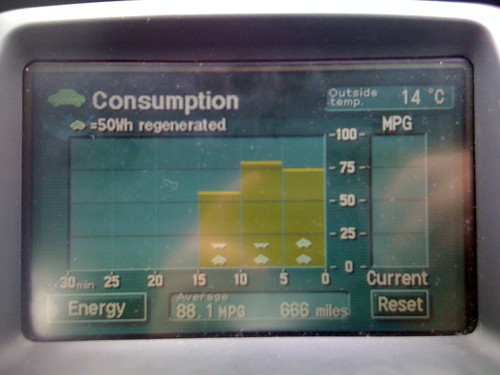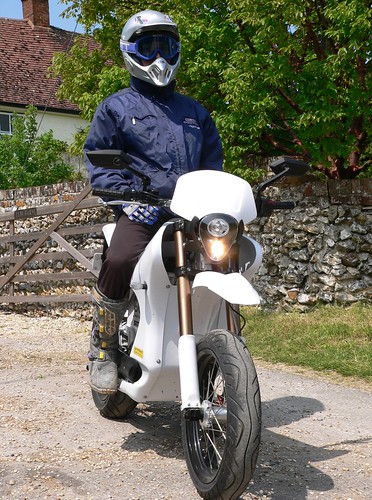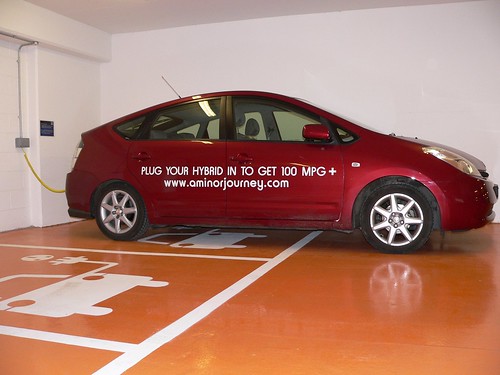Ev’ie. Another broken dream?
If you’re a regular visitor to www.aminorjourney.com you’ll know that I’ve ran stories on the Electric Car Corporation and their line of converted Citroen C1s, which they call the C1 “Ev’ie”. It all started back in April, when the Citroen Ev’ie jumped onto the market. The team behind the advertising campaign had used a sign-written petrol-powered car for photo shoots and had omitted to change the number plate. It lead to me speculating if the vehicle even existed.
Later on, a test-drive from What Car? appeared, in which the team reviewing it had some issues with acceleration and a battery overheating on the drive. You can watch the video at their website.
I’m not the sort of person to give a company a hard time unnecessarily, and felt that perhaps my initial story was a bit hard on ECCPlc, the makers of the Citroen C1 Ev’ie. So, I arranged a trip down to London to test the Ev’ie for myself. I really wanted the car to blow me away. I so badly wanted the Ev’ie to make me feel all kinds of guilt for being nasty about it in the past without even having driven it. I wanted it to make me love it. But as I quickly found, my relationship with the Ev’ie that wasn’t going to be a plain-sailing one.

Read on after the jump for a run-down of the vehicle and our eventful test-drive.
Charging discrimination instead of charging for all.
London is often viewed as the EV charging capital of the world. Thanks to the Congestion Charging zone and it’s exemptions for electric and other green vehicles, not to mention the success of the small G-Wiz and similar small electric vehicles London appears, at least on the face of it, to be a brilliant place to be if you want to own an EV.
Not only that, but there’s now over 100 public electric vehicle charging points spread throughout the greater London area. In order to use one, you have to satisfy a series of criteria to ensure that you’re a) an electric vehicle owner and b) that you agree to abide by the fair usage policies the charging points have.
But wait. What’s this? London Boroughs (think of them as small council district within the greater London area) may appear to provide charging points to electric and PHEV vehicle drivers but they’re rather picky about who can use their points.

photo by Shiner Clay
More after the jump
The new European plug.
Welcome folks, to the new charging standard for EVs and PHEVs in the European Union. It’s based on a design by Mennekes, and will support a range of charging options for EVs at anything from a standard 13A, 240V supply through to a mighty 400V three-phase, 63A supply.
Best of all, it seems like the Mennekes system is designed with interoperability in mind and may even offer some retro-fitting for suitable vehicles.
With Elektromotive set to roll out a series of upgrades to it’s charging points in the UK to allow for a ‘pay as you go’ charging system (as well as a new version of their Elecktrobay charging station supporting the new standard) there really isn’t a better time to look into going electric.

More details of the new charge standard after the jump
Range Anxiety? What Range Anxiety?
For new electric vehicle owners, one of the biggest fears (at least at the moment with few charging stations publicly available) is running out of electricity when making a longer-than usual trip. For those of us who have been driving a plug in vehicle for some time the range anxiety is much less because we know the limits of our vehicles. However, any trip to the ‘maximum’ theoretical of our vehicle’s range always spawns nervousness.
After he saw the theoretical range of the Tesla would reach the Yosemite National Park, one adventurous Tesla owner decided to prove the Tesla sales team correct and take a trip out there for himself.

Photo By William A Arnett.
More after the Jump.
It’s official. The iMiev is on it’s way.
Playing the mileage game.
Former CMO of Tesla Motors Darryl Siry, (now a Senior Analysist of Cleanteach at Peppercom) has called for auto makers to be more clear about the abilities and range of their electric and plug-in vehicles. It’s a subject I‘ve touched on in the past, but felt it worth revisiting considering the excellent article.
It’s a common problem with all EVs on the market today. Like their petrol-powered counterparts, sales teams just can’t help themselves when it comes to providing optimistic range figures for their vehicles. It’s common practice, but as Darryl eloquently argues, it could jeopardize the very heart of the EV industry before it’s fully got off the ground.
The public don’t like being made to feel that they are being lied to. And while, on a purely technical level, no car company is lying when it claims a car can do 56 mpg on it’s urban cycle, or that the range of that funky new EV is a salivating 200 miles. But at the same time the auto industry doesn’t like to tell you the full story.

More after the jump.
Drive up. Switch out. Drive on. Is it that simple?
Project Better Place have just released a video of a Nissan Crossover SUV EV at a Yokohama facility, switching out a discharged high-power EV battery pack for a fully-charged replacement. The EV then drives off on it’s merry way. It takes less than two minutes to complete. It’s an impressive video.
But is the future of electric vehicles dependent on fast battery switching, or is it an unnecessary complexity?
Let’s look at the things which we’d need to satisfy in order for a high-power battery switch out station to become a reality.
More after the jump.
Zero % Scooter 100% motorbike.
I’ve just got back from the UK launch party for the two hottest electric motorbikes to hit the European market this year. (Zero launched the Zero X electric dirt bike in 2008, but we’ve not had the chance to get our leather-clad hands on them yet.)
Today however, the UK arm of Zero motorcycles launched the Zero S and Zero X to the UK market. For the small, select bunch of people gathered there there was only one reaction. WOW.
Unlike some of the electric ‘motorbikes’ which came before, the Zero S and Zero X are actually real motorbikes. There’s not a hint of scooter about them, unlike the Vectrix Maxi Scooter, which has for a long time had to deal with criticism from the biker community that it was nothing more than the plaything of rich commuters.
In fact, the Zero S (The road-legal version of the Zero Motorbike) is about as far removed from the Vectrix as you can get. Small, nippy and surprisingly fast, it’ll do up to 60 mph and has a maximum range of 60 miles. Although, I have to admit, if you’re going to have as much fun as the people trying them out today at the launch, perhaps that range won’t quite bit that far. Thanks to the incredibly low weight of the road bike (102.1kg) it’s got a phenomenal accelration and while I didn’t ride it myself (I had strict instructions from my partner and my family to never get a motorbike) I could see the grins on those who did take it for a spin on the quiet Hampshire lanes surrounding the launch venue.

More after the jump, including some photographs of the Zero X being ridden off-road
Shell won’t plug in to electrics. Their loss
The CEO of the Shell fuel company, Jereoen van der Veer has recently been heard to be mocking electric vehicles, calling them “Milk Floats
Worse still, van der Veer made his comments at a Shell sponsored Eco-rally in Germany, where the primary goal is to travel as far as possible on as little fuel as possible. Many eco rallies even have electric vehicle entrants. The CEO of Shell claims instead that biofuels are the way to go. (At least he’s no-longer advocating hydrogen eh?)
Van der Veer claims that electric vehicles have old technology, which have barely moved on since the days of the milk-float. He also claimed that the support infrastructure needed to run electric vehicles would be extremely costly to set up. Perhaps the Dutch don’t use electricity to run their homes, but last time I checked every home (with a few exceptions) has access to electricity. In fact, electricity is more widely disseminated than petrol, so you could argue that the infrastructure is LESS.

More after the jump
